
Features
Herbicides
Seed & Chemical
Identifying and controlling the ‘obnoxious eight’
Although the number of weed species resistant to Group 2 herbicides has not increased appreciably in Ontario recently, says Dr. Peter Sikkema,
August 13, 2010 By Treena Hein
Although the number of weed species resistant to Group 2 herbicides has not increased appreciably in Ontario recently, says Dr. Peter Sikkema, it is probable that the number of fields with Group 2-resistant weeds is increasing. “For the individual farmer that has Group 2-resistant weeds, it’s a big concern,” notes Sikkema, who is professor of field crop weed management at the University of Guelph-Ridgetown Campus.
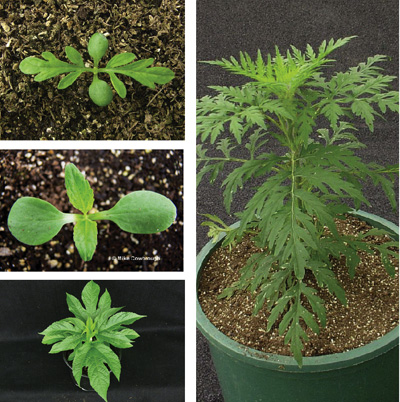
|
|
| As resistance in various weed species continues to challenge growers, the need is greater to be able to identify the difference between common ragweed (in its seedling stage (top left) and at its mature stage (right)), and giant ragweed (at seedling (middle left) and as a mature plant (bottom left)). All photos courtesy of Mike Cowbrough, OMAFRA. |
Dr. Francois Tardif, associate professor in plant science at the University of Guelph, says the increasing number of fields featuring Group 2-resistant and multiple herbicide-resistant weeds may be due to more growers engaging in conventional soybean cultivation in 2009.
“Identity Preserved (IP) premiums were strong, so IP acreage was way up,” agrees Regina Rieckenberg, sales and marketing manager for Valent Canada, Crop and Professional Products.
 |
|
| Lamb’s-quarters as a seedling (left) and with toothed margins on its leaves (right) has one of the longer-standing histories of resistance, dating back to 1973 with resistance to atrazine. |
Some of this IP acreage likely was on rented land, says Tardif, on which growers had previously raised Roundup Ready soybeans. This, along with custom combining, could have contributed to the presence of more Group 2-resistant weeds, he notes. “The bigger the farm, the harder resistance is to manage.”
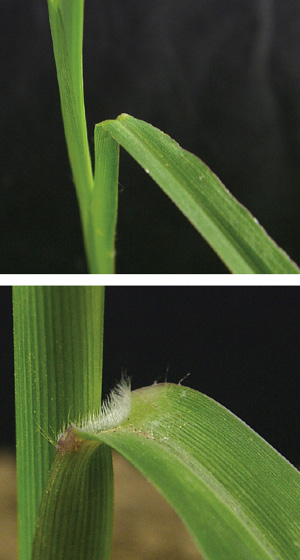 |
|
| The presence of hairs on the ligules is one method of differentiating barnyard grass (top) from green foxtail (above).
|
Mike Bakker, BASF’s corn and bean market manager, observes that producers who have not grown IP soybeans in some time may need to relearn how to manage weeds in this context. One of the two main keys is using herbicides with multiple modes of action. “Growers also have to select the correct weed chemistry pre-emergence and post-emergence,” notes Bakker. “That means identifying weeds correctly when they’re small.”
He adds that he observed a larger than expected number of growers in 2009 who waited too long to control post-emergent weeds.
Mike Cowbrough, field crop weed management lead for the Ontario Ministry of Agriculture, Food and Rural Affairs, believes the use of pre-emergent herbicides is a must. “Growers should definitely use a pre-emergent program because if it fails to some extent (due to the presence of herbicide-resistant weeds), there is an opportunity to go back and correct things effectively in post-emergence,” he says. “If all you are using is a post-emergent program and it fails, you will have a very hard time cleaning up afterward.”
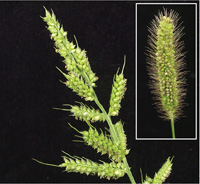
|
|
| The configuration of the seed head on barnyard grass (left) is also different from that of green foxtail (inset). |
In addition, Cowbrough has observed that although a two-pass system offers the most consistent level of weed control and yields, it is also the most expensive.
Herbicide trial results
To help with making herbicide program decisions, Cowbrough and Tardif conduct annual head-to-head comparison trials of programs with multiple modes of action, funded by the Grain Farmers of Ontario and the University of Guelph. However, Cowbrough stresses that before they look at the trial results, growers should first determine what is in their fields. “There are currently 11 weed species resistant to Group 2 herbicides in Ontario since they first appeared in 1996-1997,” he notes, “but a few of these species are closely related.”
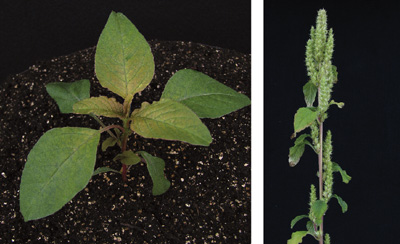 |
|
| According to OMAFRA’s Mike Cowbrough, growers must be careful in distinguishing between green pigweed at seedling (left) and mature (right) stages, and its close relatives, waterhemp and redroot pigweed (not pictured).
|
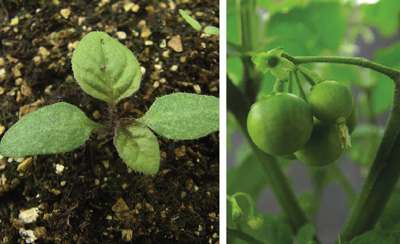 |
|
| Among the many methods of distinguishing weeds, eastern black nightshade (seedling [left] and with maturing berries [right] is often mistaken for redroot or green pigweed, but its leaves are hairy and wavy toothed, compared to the two types of pigweed. |
For example, waterhemp is a “cousin” to red and green pigweed, while green and giant foxtail are also very similar. Growers in North America should therefore focus on identifying and controlling eight weed species, says Cowbrough. These “obnoxious eight” have been observed as high risk for multiple resistance here in Ontario, and also identified as such on www.weedscience.org, a website that features up-to-date survey results on the global evolution of herbicide-resistant weeds.
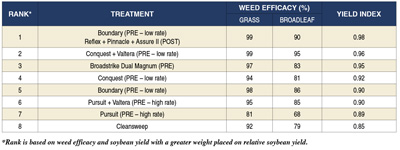 |
|
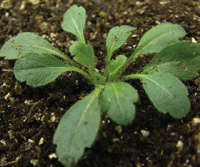 |
|
| At seedling stage, Canada fleabane’s leaves change from round-oval to oval with two to three notches and a rounded apex.
|
|
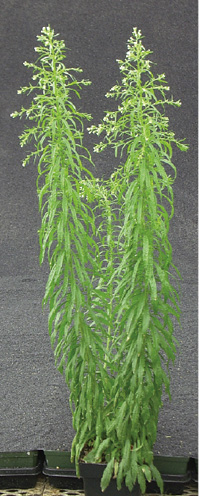 |
|
| The mature plants are easy to distinguish with the appearance of short white florets, which turn fluffy at full maturity.
|
Also important to consider alongside the trial results is cost, says Cowbrough. “There are some programs that control the eight with multiple modes of action, but there is a range of prices,” he says. “The trials do not take costs into account, so keep in mind that if one herbicide has four modes of action, but is $50 an acre more than a program that provides two modes of action, it might not be worth it.”
The trial results provide a ranking of the top weed management programs for non-GMO soybeans based on overall weed efficacy and yield (see table).
In terms of other trial results, the following is a listing of herbicides that provide less than 80 per cent control for some specific weeds:
- Barnyard grass: Pursuit (PRE – high rate)
- Lamb’s-quarters (triazine resistant): Boundary (PRE – low rate)
- Pigweed species (group 2 resistant): Pursuit (PRE – high rate)
- Ragweed: Boundary (low rate), Conquest, Pursuit, Pursuit + Valtera.
In terms of tufted vetch, Conquest + Valtera was the only program found to provide reasonable suppression.
For more information: